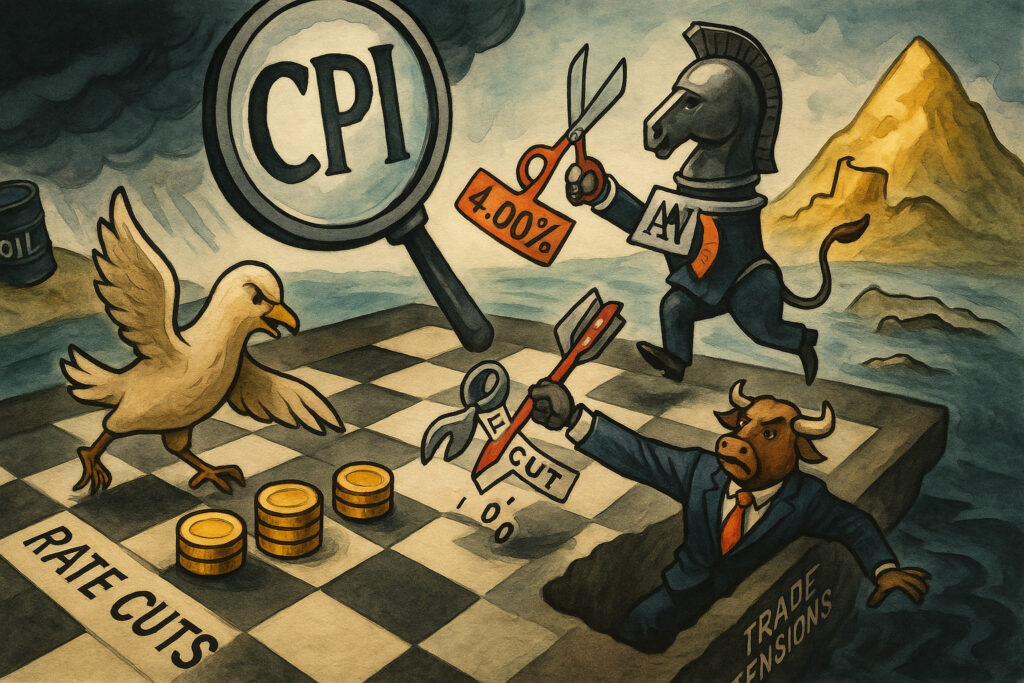Introduction
On August 10, 2025, global markets entered a phase of mounting anticipation and divergence as major central banks leaned toward easing, even amid creeping inflation pressures. U.S. Federal Reserve officials reiterated their calls for multiple rate cuts this year, buttressed by deteriorating labor data, sending equity futures higher and bond yields lower. The Bank of England cemented its dovish trajectory with another contentious rate cut, while markets recalibrated inflation expectations in its wake.
Emerging markets roiled in response to renewed trade tensions, with Indian equities particularly pressured from rising tariff risks. Meanwhile, the global outlook remains tethered to upcoming U.S. Consumer Price Index data, which is expected to play a pivotal role in validating or derailing the current easing narrative. This article provides a comprehensive examination of these developments and their unfolding implications across asset classes and regions.
Fed’s Dovish Shift Strengthens as Labor Fragility Mounts
The Federal Reserve’s dovish tilt was reinforced amid mounting evidence of labor market softness. Vice Chair Michelle Bowman described recent jobs data as signaling “signs of fragility,” reinforcing her long-held forecast calling for three rate cuts this year. She emphasized the urgency of low rates to preemptively cushion the economy against further labor deterioration—a position gaining traction within policy circles. Meanwhile, anticipation of upcoming inflation readings has markets leaning toward a potentially decisive pivot at September’s meeting, with easing expectations climbing steadily.
Bond Markets Rally Ahead of CPI
Bond markets responded promptly, with U.S. Treasury yields retracing lower as investors digested the dovish message. Demand surged in short- and medium-term maturities as the likelihood of rate cuts intensified. The yield curve steepened modestly, signaling renewed confidence in growth alongside easier monetary conditions. Yet, caution lingers ahead of Tuesday’s U.S. CPI release, which will be closely scrutinized for clues about inflation’s trajectory.
Equities Benefit from Easing Policy Sentiment
Global equity markets rallied on the dovish narrative, with U.S. stock futures making gains. Once again, technology and rate-sensitive sectors outperformed, buoyed by the anticipatory mood. Analysts noted that historical precedent supports strong equity returns in early-stage rate-cut cycles—sometimes upwards of 30 percent over the cycle. However, caution remains among strategists given elevated valuations, geopolitical risks, and fragile labor data.
Bank of England Maintains Dovish Path Despite Headwinds
Across the Atlantic, the Bank of England delivered a narrow but decisive rate cut, trimming the benchmark rate to 4.0 percent—the fifth cut in a year. The move was marked by a tight 5–4 vote, indicating elevated internal dissent as inflation remains well above target and growth remains anemic. Policymakers acknowledged rising private-sector costs and weaker labor conditions, underscoring a delicate balance between easing and inflation containment. Pound sterling and gilt yields reacted, with the currency gaining modestly and yields climbing slightly as markets priced in slower future cuts.
India’s Equity Markets Under Pressure
Indian markets ended the week on a subdued note. The Nifty 50 fell below key technical levels amid rising trade tensions and systemic uncertainty. Analysts caution of further downside unless bullish triggers emerge—in particular, rates-sensitive sectors are under scrutiny. With U.S.-India tariff threats mounting and foreign institutional investors remaining on alert, sentiment remains fragile. Key domestic earnings and macro data in the coming days will be critical in anchoring investor confidence.
Commodities: Oil Slightly Higher, Gold Holds Firm
Crude oil prices rebounded modestly, supported by expectations of stabilizing global demand and easing geopolitical tensions. Brent traded near the upper $70s, while WTI held steady around mid-$70s. Gold, bolstered by monetary easing prospects and inflation risk, remained elevated near its record highs, underscoring its role as a hedge amid policy uncertainty.
M&A and Global Liquidity Remain Supportive
Despite caution elsewhere, global M&A activity continues to exhibit resilience. Deal volumes have surged, supported by robust bidder appetite and abundant liquidity. This ongoing merger and acquisition wave has provided structural support for equities, especially in sectors tied to AI and infrastructure, as firms seek scale amid tightening margins and cost challenges.
Conclusion
August 10, 2025 encapsulated a global landscape increasingly influenced by policy divergence, easing expectations, and strategic recalibration.
Key takeaways include:
- The Fed’s dovish momentum strengthened as labor market weakness compelled growing support for rate cuts.
- Treasury yields fell in anticipation of softer policy, though inflation data may refine the path ahead.
- Global equities, particularly in tech and cyclicals, benefited from easing narratives, even amid elevated valuations and fragility.
- The BoE’s contentious rate cut reflects a delicate balancing act between inflation and stagnation.
- Indian equities remain vulnerable amid trade friction and investor outflows.
- Commodities show mixed signals—oil supported by demand hopes; gold elevated as a hedge amid uncertainty.
- M&A activity and liquidity remain tailwinds supporting valuations amid structural repositioning.
Looking ahead, markets must watch:
- Tuesday’s U.S. CPI reading—and whether it confirms or pressures current expectations of imminent easing.
- Fed messaging clarity around the timing and pace of rate cuts.
- How inflation and growth data influence the BoE’s policy trajectory.
- Whether Indian markets find stabilization or succumb to broader global headwinds.
- Whether M&A momentum and corporate demand can sustain investor support amid fragile macro conditions.
As August progresses, the tight nexus between policy, data, and capital flows demands vigilance. Investors should consider strategies aligned to easing conditions while maintaining resilience against volatility and slowing fundamentals.
